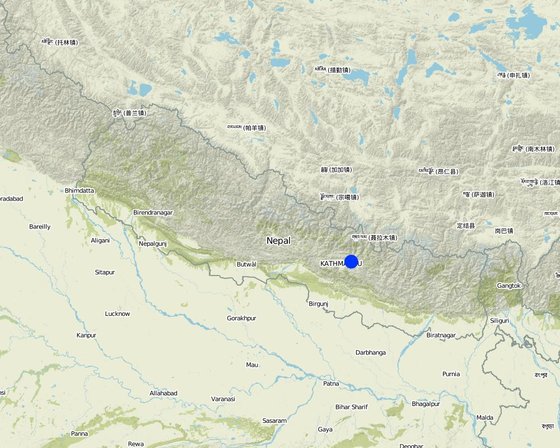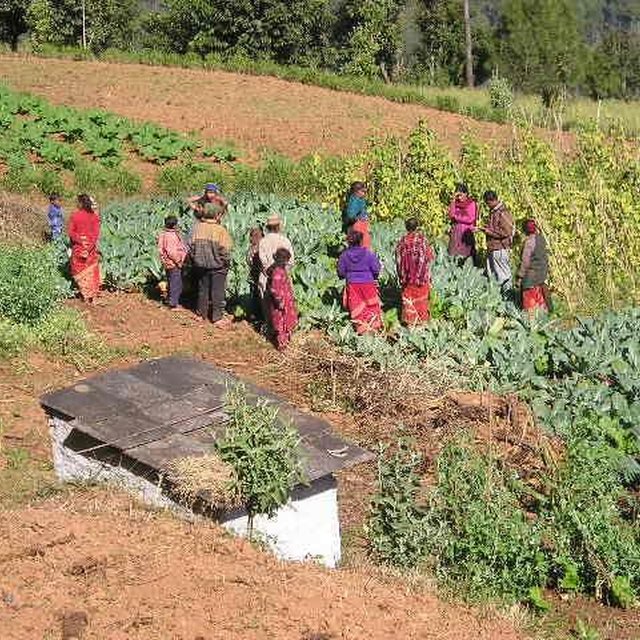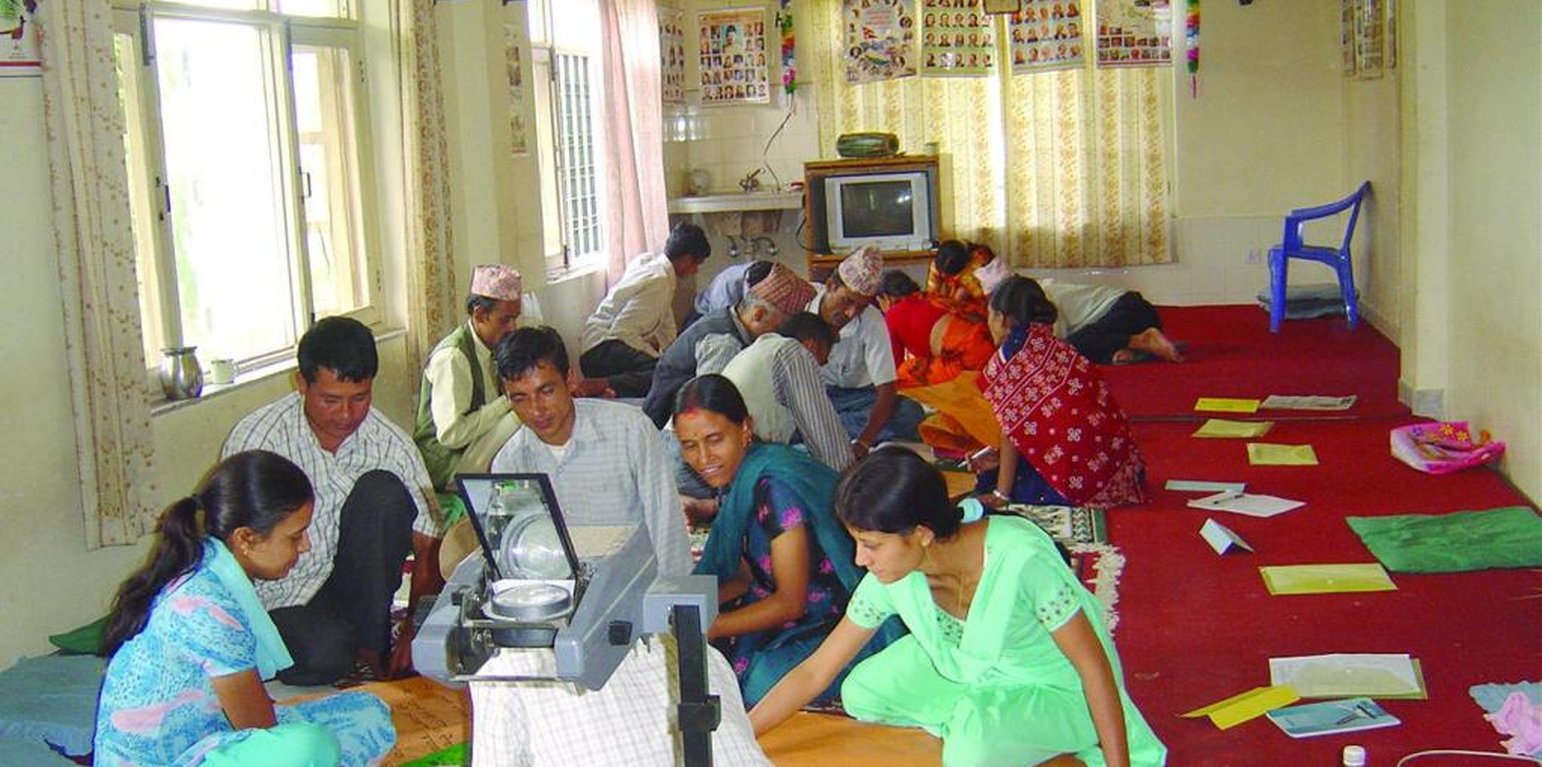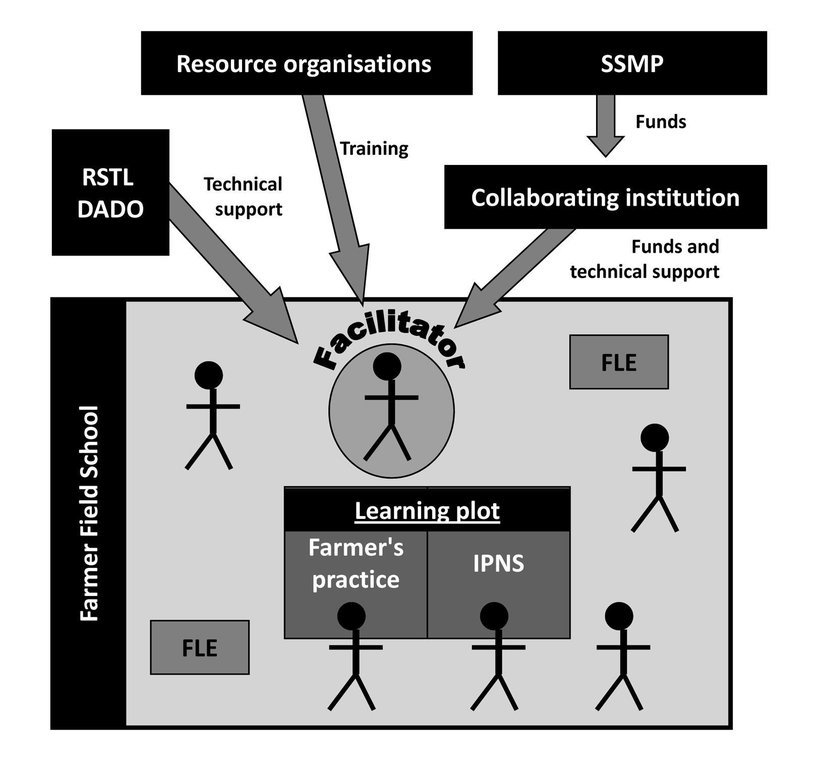Farmer field schools on integrated plant nutrient systems
(Nepal)
Krishak Pathsala (Nepali)
Descrição
Participatory and collaborative learning through the farmer field school approach
There are different ways of carrying out agricultural extension. Farmer field schools represent a participatory approach that directly reaches farmers and addresses their day-to-day problems. The concept of farmer field schools builds on the belief that farmers are the main source of knowledge and experience in carrying out farm operations, in contrast to conventional top-down approaches that place most value on scientists' findings. The term 'farmer field schools' came from the Indonesian expression 'sekolah lapangan' which means 'field school'. It is a group based learning approach, which brings together concepts and method of agro-ecology, experiential education, and community development. The first field schools were established in 1989 in central Java when 50 plant protection officers tested and developed field training methods as part of an integrated pest management (IPM) training of trainers course. Two hundred field schools were established in that season involving 5,000 farmers. The following season, in 1990, an additional 45,000 farmers joined field schools run by 450 crop protection officers.
The same approach is being used in Nepal's integrated pest management programme. Several consultation meetings and workshops were held at national level to put the integrated nutrient management concept into practice. These meetings led to farmer field schools being recognised as an appropriate approach for putting this concept into practice. The approach was piloted in 2000 and 2001 and fully initiated in 2002 when 32 farmer field schools were run with support from SSMP. As far as SSMP knows, farmer field schools on integrated plant nutrient systems have been run since SSMP's involvement. The Government of Nepal's National Fertiliser Policy now recognises integrated plant nutrient systems as a concept to improve the efficient use of different nutrient inputs, and farmer field schools as an appropriate technology and extension approach for soil and plant nutrient management in Nepal. So far some 226 farmer field schools have been run in Nepal on integrated plant nutrient systems reaching more than 5,000 households.
Localização

Localização: Midhills, Nepal
Geo-referência de locais selecionados
Data de início: n.a.
Ano de término: n.a.
Tipo de abordagem
-
Tradicional/Indígena
-
Iniciativa/inovação local recente
-
Baseado em projeto/programa

Farmers observing a caulifl ower plot during a regular farmer field school session (Steffen Schulz)
Objetivos de aproximação e ambiente propício
Principais metas / objetivos da abordagem
Transfer of technology to farmers on soil and plant nutrition management. Empowerment of farmers. Production of healthy crops without negative environmental effects.
The SLM Approach addressed the following problems: Lack of effective and efficient ways of transferring technologies to farmers. Conventional approach of technology transfer, where farmers are believed to have poor knowledge and skills. Farmers are always perceived as a recipient of technology and knowledge
Condições que permitem a implementação da Tecnologia(s) aplicada(s) sob a Abordagem
Condições que dificultam a implementação da Tecnologia(s) aplicada(s) sob a Abordagem
-
Normas e valores sociais/culturais/religiosos: Group: unintegrated, less organised group
-
Conhecimento sobre GST, acesso a suporte técnico: Soil-fertility management, plant nutrient dynamics
-
Outro: Extension: Top-down, technology-centred, not farmer-centred
Participação e papel das partes interessadas envolvidas
Partes interessadas envolvidas na abordagem e seus papéis
| Que partes interessadas/órgãos de implementação estavam envolvidos na abordagem? |
Especifique as partes interessadas |
Descreva o papel das partes interessadas |
| Usuários de terra/comunidades locais |
|
|
| Especialistas em GST/ consultor agrícola |
|
|
Envolvimento do usuários de terra/comunidades locais nas diferentes fases da abordagem
Nenhum
Passivo
Apoio externo
Participativo
Automobilização
Iniciação/motivação
Participatory approach: group discussions involving all local stakeholders
Planejamento
Orientation workshop involving all stakeholders - farmers participation is crucial
Implementação
Farmers are the key actors with trained staff of collaborating institutions (CI) facilitating the process
Monitoramento/avaliação
Farmers evaluate and monitor jointly on a regular basis
Research
Farmer-led experimentation based on local needs and context
Fluxograma
Farmer field schools are usually facilitated by a field staff member of a collaborating institution and funded by SSMP. The facilitators are supported technically by the regional soil testing
Tomada de decisão sobre a seleção da Tecnologia GST
As decisões foram tomadas por
-
Somente usuários da terra (iniciativa própria)
-
Principalmente usuários da terra, apoiados por especialistas em GST
-
todos os atores relevantes, como parte de uma abordagem participativa
-
Principalmente especialistas em GST, após consulta com usuários da terra
-
Somente especialistas em GST
-
Políticos/líderes
As decisões foram tomadas com base em
-
Avaliação de conhecimento bem documentado de GST (tomada de decisão baseada em evidências)
-
Resultados de pesquisa
-
Experiência pessoal e opiniões (não documentado)
Suporte técnico, reforço das capacidades e gestão do conhecimento
As seguintes atividades ou serviços têm sido parte da abordagem
-
Reforço das capacidades/ formação
-
Serviço de consultoria
-
Fortalecimento da instituição (desenvolvimento organizacional)
-
Monitoramento e avaliação
-
Pesquisa
Reforço das capacidades/formação
Foi fornecido treinamento às seguintes partes interessadas
-
Usuários de terra
-
Equipe de campo/consultores
Tipo de formação
-
Em exercício
-
Agricultor para agricultor
-
Áreas de demonstração
-
Reuniões públicas
-
Cursos
Assuntos abordados
A training of trainers course is provided to selected staff from the collaborating institutions who have been involved substantially in agriculture development and farming practices activities. Seven days basic training on integrated plant nutrient systems and farmer field schools is provided. There is provision for a sharing forum at district level based on the demand of staff involved in conduc
Fortalecimento institucional
As instituições foram fortalecidas / estabelecidas
-
Não
-
Sim, pouco
-
Sim, moderadamente
-
Sim, significativamente
Descreva instituição, papéis e responsabilidades, membros, etc.
Tipo de apoio
-
Financeiro
-
Reforço das capacidades/ formação
-
Equipamento
Mais detalhes
Local level organisations are involved in carrying out the farmer field schools. Local institutions are supported financially and technically by SSMP. The major aim of this approach is to build local
Monitoramento e avaliação
socio-cultural aspects were regular monitored through observations; indicators: status
bio-physical aspects were regular monitored through measurements; indicators: nitrate, nitrogen, pH, organic matter, P and K, yield measurements
technical aspects were regular monitored through observations; indicators: cash income
economic / production aspects were regular monitored through observations
Pesquisa
As pesquisas trataram dos seguintes tópicos
-
Sociologia
-
Economia/Marketing
-
Ecologia
-
Tecnologia
It is difficult to compare results if many treatments are applied at the same time in a plot. Therefore, it is always advised that component trials are run for different treatments. Such trials make for easier understanding of the different treatments and enable farmers to see the effects of particular treatments.
Financiamento e apoio material externo
Orçamento anual em USD para o componente GST
-
< 2.000
-
2.000-10.000
-
10.000-100.000
-
100.000-1.000.000
-
> 1.000.000
Precise annual budget: n.a.
Approach costs were met by the following donors: local government (district, county, municipality, village etc) (participants): 20.0%; other (development project): 80.0%
Os seguintes serviços ou incentivos foram fornecidos aos usuários de terras
-
Apoio financeiro/material concedido aos usuários da terra
-
Subsídios para insumos específicos
-
Crédito
-
Outros incentivos ou instrumentos
Análise de impactos e declarações finais
Impactos da abordagem
Não
Sim, pouco
Sim, moderadamente
Sim, significativamente
A abordagem auxiliou os usuários da terra a implementar e manter as tecnologias de GST?
Attendance at farmer field schools has led to many farmers adopting practices that have improved the fertility status of their soils and have increased crop productivity. Most of these farmers have realised the need for the judicious use of local and external resources to increase crop production
Principal motivação dos usuários da terra para implementar a GST
Atividades de sustentabilidade de abordagem
Os usuários da terra podem sustentar o que foi implementado através da Abordagem (sem apoio externo)?
Capacity remains at the local level so that farmers are able to run farmer field schools themselves.
Conclusões e experiências adquiridas
Pontos fortes: visão do usuário de terra
Pontos fortes: a visão do/a compilador/a ou de outra pessoa capacitada
-
Farmers are the source of knowledge; farmers adopt technologies based on their context (How to sustain/ enhance this strength: Involve farmers in a more participatory way)
-
Participatory approach
-
Farmers decide the pace of implementation and what should be done
-
The schools stress the importance of using local resources to reduce dependency on external resources
-
Increased effi ciency and effectiveness of local resources use
Pontos fracos/desvantagens/riscos: visão do usuário de terracomo superar
Pontos fracos/desvantagens/riscos: a visão do/a compilador/a ou de outra pessoa capacitadacomo superar
-
Farmer field schools need time and their costs are higher than other similar approaches
-
Non-technical staff are often involved in carrying out farmer field schools
Ensure capacity building and regular sharing forums
Referências
Data da documentação: 19 de Janeiro de 2009
Última atualização: 28 de Junho de 2017
Pessoas capacitadas
-
Richard Allen (richkga@gmail.com) - Especialista em GST
-
Soil Management Directorate - Especialista em GST
-
Team Leader Sustainable Sustainable Soil Management Programme (SSMP) (ssmp@helvetas.org.np) - Especialista em GST
Descrição completa no banco de dados do WOCAT
A documentação foi facilitada por
Instituição
- HELVETAS (Swiss Intercooperation)
Projeto
- Sustainable Soil Management Programme, Nepal (SSMP)
Referências-chave
-
Paudel, C.L.; Regmi, B.D.; Schulz, S. (2005) 'Participatory Innovation Development - Experiences of the Sustainable Soil Management Programme in Nepal:
-
SSMP (2003) Introduction to Integrated Plant Nutrient Systems (in Nepali). Kathmandu: Sustainable Soil Management Programme: SSMP
-
In Kolff, A.; van Veldhuizen, L.; Wettasinha, C. (eds) Farmer Centred Innovation Development ???? Experiences and Challenges from South Asia, pp. 109-126. Bern: Intercooperation: SSMP






